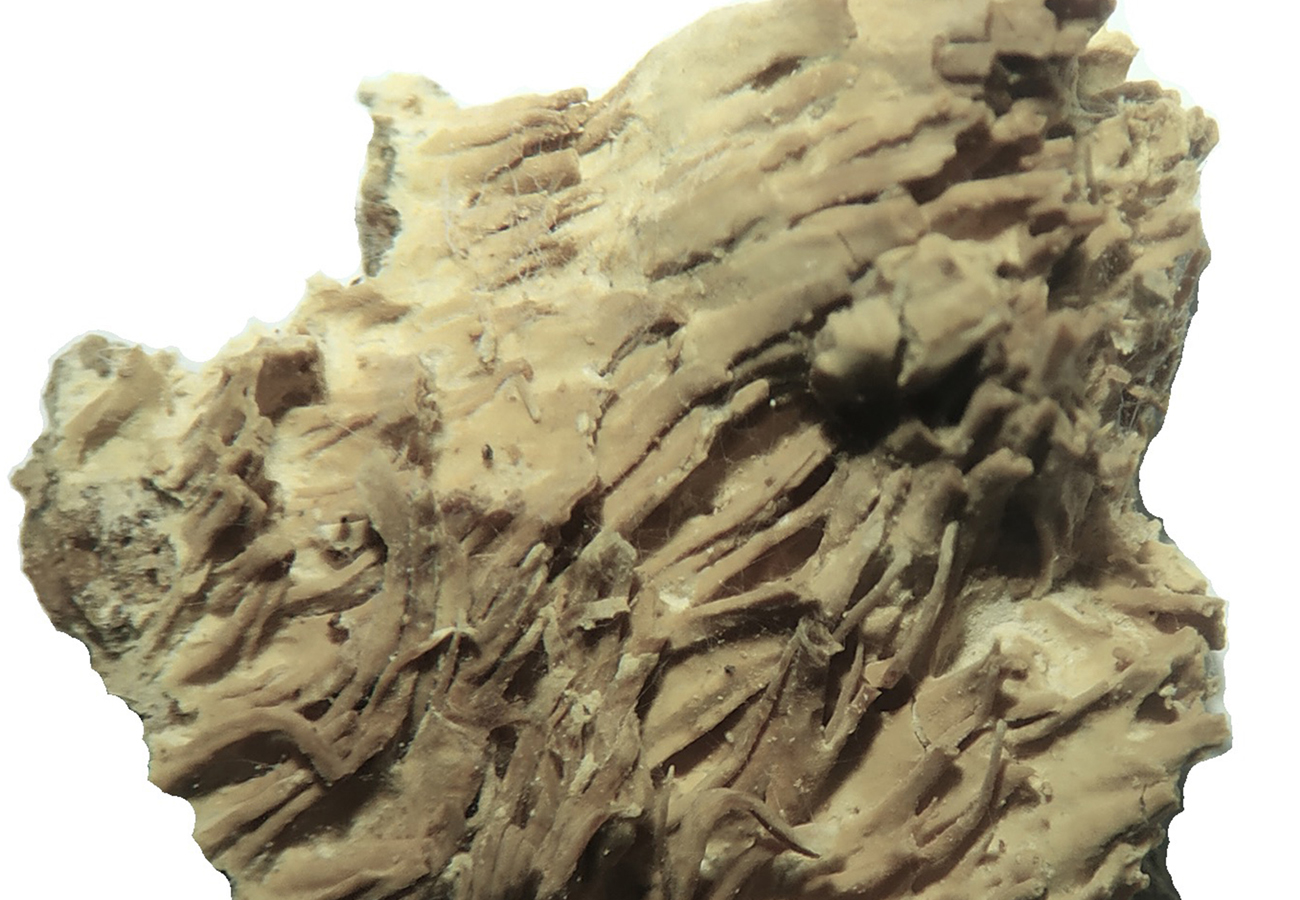Abstract
In this study, Pseudolagarobasidium pallens sp. nov. is proposed based on morphological and phylogenetic studies. Specimens were collected in Brazil and used for DNA sequence analyses of the internal transcribed spacer and the large subunit of the nuclear ribosomal RNA gene. The basidiomes of P. pallens are characterized by a pale cream coloration when fresh, hydnoid hymenophore with long teeth and thin whitish context. Microscopically, it differs from other related species by the larger basidiospores (4.6–)4.9–6.4(–6.8) × 3.2–4.5 µm. Phylogenetically, it is closely related to P. belizense. We also provide sequences of the Brazilian species Cerrena cystidiata for the first time and confirm that is closely related to the generic type C. unicolor. A taxonomic key to all species currently accepted in Pseudolagarobasidium and a brief discussion on the family Cerrenaceae as well as a comparison table of all its genera are also presented.
References
<p> https://doi.org/10.1111/j.1095-8339.1873.tb00301.x</p>
<p>Binder, M., Justo, A., Riley, R., Salamov, A., Lopez-Giraldez, F., Sjökvist, E., Copeland, A., Foster, B., Sun, H., Larsson, E., Larsson, K.H., Townsend, J., Grigoriev, I.V. & Hibbett, D.S. (2013) Phylogenetic and phylogenomic overview of the Polyporales. <em>Mycologia</em> 105: 1350–1373.</p>
<p> https://doi.org/10.3852/13-003</p>
<p>Darriba, D., Taboada, G.L., Doallo, R. & Posada, D. (2012) jModelTest 2: more models, new heuristics and parallel computing. <em>Nature Methods</em> 9: 772–772.</p>
<p> https://doi.org/10.1038/nmeth.2109</p>
<p>Doyle, J.J. (1987) A rapid DNA isolation procedure for small quantities of fresh leaf tissue. <em>Phytochem Bulletin</em> 19: 11–15.</p>
<p>Dupérré, N. (2020) Old and new challenges in taxonomy: what are taxonomists up against? <em>Megataxa</em> 1 (1): 59–62.</p>
<p> https://doi.org/10.11646/megataxa.1.1.12</p>
<p>Fries, E.M. (1836) Corpus Florarum provincialium suecicae I. <em>Floram Scanicam</em>: 1–349.</p>
<p> https://doi.org/10.5962/bhl.title.47083</p>
<p>Gray, S.F. (1821) <em>A natural arrangement of British plants</em> 1: 1–824.</p>
<p>Hall, T.A. (1999) Bioedit: a user-friendly biological sequence alignment editor and analysis program for Windows 95/98/NT. <em>Nucleic Acids Symposium Series</em> 41: 95–98.</p>
<p>Hallenberg, N., Ryberg, M., Nilsson, R.H., Wood, A.R. & Wu, S.H. (2008) <em>Pseudolagarobasidium</em> (Basidiomycota): on the reinstatement of a genus of parasitic, saprophytic, and endophytic resupinate fungi. <em>Botany</em> 86: 1319–1325.</p>
<p> https://doi.org/10.1139/B08-088</p>
<p>Han, M.L., Bian, L.S., Zhang, Y.X., Zhu, M.C. & An, Q. (2021) <em>Pseudolagarobasidium</em> <em>baiyunshanense</em> sp. nov. from China inferred from morphological and sequence analyses. <em>Phytotaxa</em> 483 (2): 169–176.</p>
<p> https://doi.org/10.11646/phytotaxa.483.2.9</p>
<p>Jang, J.C. & Chen, T. (1985) <em>Pseudolagarobasidium</em> <em>leguminicola</em> gen. et sp. nov. on <em>Leucaena</em> in Taiwan. <em>Transactions of the British Mycological Society</em> 85 (2): 374–377.</p>
<p> https://doi.org/10.1016/S0007-1536(85)80209-6</p>
<p>Justo, A., Miettinen, O., Floudas, D., Ortiz-Santana, B., Sjökvist, E., Lindner, D., Nakasone, K., Niemelä, T., Larsson, K.H., Ryvarden, L. & Hibbett, D.S. (2017) A revised family-level classification of the Polyporales (Basidiomycota). <em>Fungal Biology</em> 121: 798–824.</p>
<p> https://doi.org/10.1016/j.funbio.2017.05.010</p>
<p>Katoh, K. & Standley, D.M. (2013) MAFFT multiple sequence alignment software version 7: improvements in performance and usability. <em>Molecular Biology and Evolution </em>30 (4): 772–780.</p>
<p> https://doi.org/10.1093/molbev/mst010</p>
<p>Lohwag, H. (1931) Mykologische Studien VI. <em>Spongipellis litschaueri</em> (= <em>Polyporus</em> <em>schulzeri</em> Fr. sensu Bresadola). <em>Arch Protistenk</em> 75: 297–314.</p>
<p>Miller, M.A., Pfeiffer, W. & Schwartz, T. (2011) The CIPRES Science Gateway: a community resource for phylogenetic analyses. <em>Proceedings of the 2011 TeraGrid Conference: Extreme Digital Discovery</em>. Article 41. ACM Digital Library, New York, pp. 1–8.</p>
<p> https://doi.org/10.1145/2016741.2016785</p>
<p>Murrill, W.A. (1903) A historical review of the genera of the Polyporaceae. <em>Journal of Mycology</em> 9 (2): 87–102.</p>
<p> https://doi.org/10.2307/3752511</p>
<p>Murrill, W.A. (1905) The Polyporaceae of North America: XII. A synopsis of the white and bright-colored pileate species. <em>Bulletin of the Torrey Botanical Club</em> 32 (9): 469–493.</p>
<p> https://doi.org/10.2307/2478463</p>
<p>Murrill, W.A. (1907) Polyporaceae, Part 1. <em>North American Flora</em> 9 (1): 1–72.</p>
<p>Nakasone, K.K. & Lindner, D.L. (2012) Taxonomy of <em>Pseudolagarobasidium</em> (Polyporales, Basidiomycota). <em>Fungal Diversity</em> 55 (1): 155–169.</p>
<p> https://doi.org/10.1007/s13225-012-0161-1</p>
<p>Nakasone, K.K. (2015) Taxonomic studies in <em>Chrysoderma</em>, <em>Corneromyces</em>, <em>Dendrophysellum</em>, <em>Hyphoradulum</em>, and <em>Mycobonia</em>. Mycotaxon 130: 369–397.</p>
<p> https://doi.org/10.5248/130.369</p>
<p>Nikolcheva, L.G. & Bärlocher, F. (2004) Taxon-specific primers reveal unexpectedly high diversity during leaf decomposition in a stream. <em>Mycological Progress</em> 3: 41–49.</p>
<p> https://doi.org/10.1007/s11557-006-0075-y</p>
<p>Oghenekaro, A.O., Miettinen, O., Omorusi, V.I., Evueh, G.A., Farid, M.A., Gazis, R. & Asiegbu, F.O. (2014) Molecular phylogeny of <em>Rigidoporus microporus</em> isolates associated with white rot disease of rubber trees (<em>Hevea brasiliensis</em>). <em>Fungal Biology</em> 118 (5): 495–506.</p>
<p> https://doi.org/10.1016/j.funbio.2014.04.001</p>
<p>Patouillard, N. (1887) <em>Les Hyménomycètes d’Europe</em>: 1–166.</p>
<p>Rajchenberg, M. (2011) Nuclear behavior of the mycelium and the phylogeny of Polypores (Basidiomycota). <em>Mycologia</em> 103 (4): 677–702.</p>
<p> https://doi.org/10.3852/10-310</p>
<p>Rajchenberg, M. & de Meijer, A.A.R. (1990) New and noteworthy polypores from Paraná and São Paulo States, Brazil. <em>Mycotaxon</em> 38: 173–185.</p>
<p>Ronquist, F., Teslenko, M., van der Mark, P., Ayres, D.L., Darling, A., Höhna, S., Largent, B.L., Suchard, M.A. & Huelsenbeck, J.P. (2012) MrBayes 3.2: efficient Bayesian phylogenetic inference and model choice across a large model space. <em>Systematic Biology</em> 61: 539–542.</p>
<p> https://doi.org/10.1093/sysbio/sys029</p>
<p>Ryvarden, L. (1972) <em>Radulodon</em>, a new genus in the Corticiaceae (Basidiomycetes). <em>Canadian Journal of Botany</em> 50 (10): 2073–2076.</p>
<p> https://doi.org/10.1139/b72-266</p>
<p>Seifert, K.A. & Rossman, A.Y. (2010) How to describe a new fungal species. <em>IMA Fungus</em> 1 (2): 109–116.</p>
<p> https://doi.org/10.5598/imafungus.2010.01.02.02</p>
<p>Stalpers, J.A. (1998) On the genera <em>Sarcodontia</em>, <em>Radulodon</em> and <em>Pseudolagarobasidium</em>. <em>Folia Cryptog Estonica</em> 33: 133–138.</p>
<p>Stamatakis, A. (2014) RAxML Version 8: A tool for Phylogenetic Analysis and Post-Analysis of Large Phylogenies. <em>Bioinformatics</em> 30: 1312–1313.</p>
<p> https://doi.org/10.1093/bioinformatics/btu033</p>
<p>Thiers, B. (2021 [continuously updated]) <em>Index Herbariorum: a global directory of public herbaria and associated staff.</em> New York Botanical Garden’s Virtual Herbarium. Available from: http://sweetgum.nybg.org/ih/ (accessed 30 June 2021)</p>
<p>Tomšovský, M. (2012) Delimitation of an almost forgotten species <em>Spongipellis litschaueri</em> (Polyporales, Basidiomycota) and its taxonomic position within the genus. <em>Mycological Progress</em> 11 (2): 415–424.</p>
<p> https://doi.org/10.1007/s11557-011-0756-z</p>
<p>Westphalen, M.C., Tomšovský, M., Gugliotta, A.M. & Rajchenberg, M. (2019) An overview of <em>Antrodiella</em> and related genera of Polyporales from the Neotropics. <em>Mycologia</em> 111 (5): 813–831.</p>
<p> https://doi.org/10.1080/00275514.2019.1633895</p>
<p>Wood, A.R. & Ginns, J. (2006) A new dieback disease of <em>Acacia cyclops</em> in South Africa caused by <em>Pseudolagarobasidium acaciicola</em> sp. nov. <em>Canadian Journal of Botany</em> 84: 750–758.</p>
<p> https://doi.org/10.1139/b06-032</p>
<p>Wu, S.H. (1990) The Corticiaceae (Basidiomycetes) subfamilies Phlebioideae, Phanerochaetoideae and Hyphodermoideae in Taiwan. <em>Acta Botanica Fennica</em> 142: 1–123.</p>
<p>Yuan, H.S. (2013) Molecular phylogenetic evaluation of <em>Antrodiella</em> and morphologically allied genera in China. <em>Mycological Progress</em> 13 (2): 353–364.</p>
<p> https://doi.org/10.1007/s11557-013-0921-7</p>


